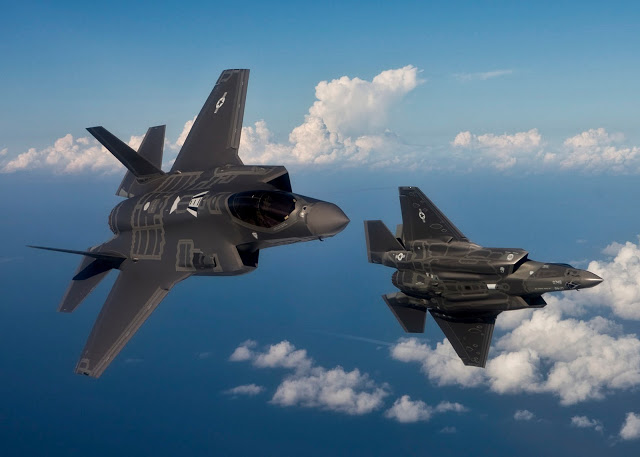Joe DellaVedova, a spokesman with the F-35 office at the Pentagon, said 45 F-35s were delivered, which met Lockheed and the program office’s delivery goal for the year and exceeded last year’s deliveries by nine jets.
“Meeting aircraft production goals is a critical stepping stone in demonstrating the program is ready for the expected significant production ramp up,” Lt. Gen. Chris Bogdan, the F-35 program’s executive officer, said in a press release.
Lorraine Martin, Lockheed’s F-35 program general manager, said the 2015 deliveries were “a clear demonstration of our growing maturity and stability.”
Of the 45 jets delivered in 2015, the lion’s share has gone to the Air Force, which has received 26 F-35As. The Marine Corps received eight F-35Bs and the Marines and the Navy each accepted four F-35Cs, which can take off and land vertically from aircraft carriers.
DellaVedova said 154 operational F-35s have been delivered to the Department of Defense and partner nations since the program’s inception. The fleet has more than 45,000 flight hours. The multirole fighter will eventually replace the Air Force’s entire fleet of F-16 Fighting Falcons and A-10 Thunderbolt IIs.
To satisfy Congress while also reassuring the dozens of countries that had invested in, or might invest in, the Joint Strike Fighter program, Air Combat Command proclaimed that its F-35A version of the new warplane would be war-ready no later than December 2016.
In order to meet the end-of-2016 deadline, the flying branch had to badly water down the F-35, diluting its ability to fight and survive against a determined enemy such as Russia, China or Iran. The jet fighter that the Air Force plans to debut sometime before January 2017 is a weak version of itself. One that by the military’s own admission won’t be capable of reliably winning a high-tech battle.
By mid-2015, Lockheed Martin had delivered around 150 F-35s to the Air Force, Marines, Navy and allied air forces. Just 10 of the jets were officially combat-ready — those belonging to Marine Fighter Attack Squadron 121 in Yuma, Arizona. The VMFA-121 planes have Block 2B software that’s compatible with just three different weapons — a 500-pound laser-guided bomb, a 2,000-pound GPS-guided bomb and the AIM-120 medium-range, radar-guided air-to-air missile. No short-range infrared dogfighting missile. No small GPS bomb. No cruise missile. No gun.
The F-35’s software and capability blocks are broken down into
Block 1A – initial training,
Block 1B – advanced training 1,
Block 2A – advanced training 2,
Block 2B (initial combat capability),
Block 3i (initial full capability), and
Block 3F (full combat capability).
The USMC recently declared initial operating capability (IOC) for its F-35B jets with the Block 2B software, enabling the fleet to conduct close air support, offensive and defensive counter air, air interdiction, assault support escort, and armed reconnaissance missions. Block 3i provides the same tactical capabilities as Block 2B, with the principal difference being the implementation of the updated Integrated Core Processor. The USAF will declare IOC for its F-35As, with one squadron of aircraft at the Block 3i standard in the third quarter of 2016.
Block 3F provides 100% of the software required for full warfighting capability, including but not limited to datalink imagery, full weapons, and embedded training. Mission Systems Block 3F software development is 98% complete and due to be rolled out in the third quarter of 2017. After Block 3F, further block upgrades will be developed and introduced. The DoD is currently balancing its future priorities with expected budgets as it looks to define its Block 4 requirements.
Canada’s withdrawal from the program will see the cost of the F-35 go up between 0.7 per cent and one per cent for other countries – or about US$1 million per plane, said Lt.-Gen. Chris Bogdan, head of the F-35 Joint Program Office.
The program is currently $200 billion over budget. It will cost an estimated $400 billion for the U.S. to buy the 2,443 aircraft it has determined it needs.
Some U.S. lawmakers are now questioning whether the Pentagon can afford to buy all of those.
John McCain, the Republican senator and chairman of the Senate Armed Services Committee, said he expects the U.S. will have to cut its number of F-35s because of costs.
SOURCES- Janes, War is Boring, US Air Force, National Post

Brian Wang is a Futurist Thought Leader and a popular Science blogger with 1 million readers per month. His blog Nextbigfuture.com is ranked #1 Science News Blog. It covers many disruptive technology and trends including Space, Robotics, Artificial Intelligence, Medicine, Anti-aging Biotechnology, and Nanotechnology.
Known for identifying cutting edge technologies, he is currently a Co-Founder of a startup and fundraiser for high potential early-stage companies. He is the Head of Research for Allocations for deep technology investments and an Angel Investor at Space Angels.
A frequent speaker at corporations, he has been a TEDx speaker, a Singularity University speaker and guest at numerous interviews for radio and podcasts. He is open to public speaking and advising engagements.


